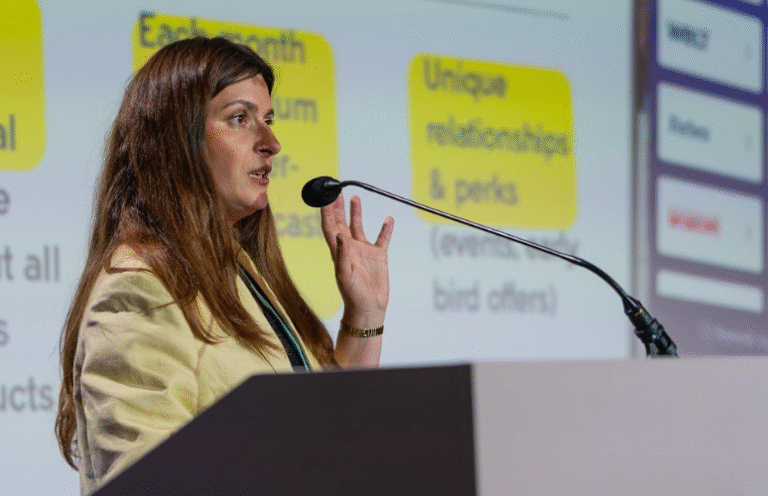Newspaper printing is shrinking, but publishers are finding ways to adapt
While print remains a significant revenue source for many news publishers, accounting for 45 percent of total income, according to our World Press Trends report, it has also been steadily declining and printers are finding new ways to diversify their revenues.
During our World Printers Summit in Munich, Sally Pirri, Vice President of Print Operations at The Globe and Mail, a leading national daily in Canada, explained how she oversees one of the country’s most extensive print and distribution networks and has outsourced their printing.
“We collaborate with the largest printer in Canada,” Pirri said during a panel discussion. Today, all five of The Globe and Mail’s print sites are outsourced, a practice common among Canadian dailies to reduce costs and competition over infrastructure.
Delegates from over 60 companies across 19 countries attended the World Printers Summit
As print volumes fall, focus shifts to longevity over expansion
Flemming Heding Pedersen, Chief Operating Officer and Production Director at Erritsø Tryk (owned by JP/Politikens Hus), manages operations that once produced about 60 percent of all Danish newspapers.
Over recent years, Erritsø Tryk has shifted from being a large-scale contract printer to operating directly under JPP as part of an in-house consolidation.
The past few years have been about scaling down, according to Pedersen. “We’ve closed two large printing plants and removed 10 double-wide double-round towers, four folders, and two postpress facilities.”
Today, the company runs just two plants. “Our goal now is to keep those running for as long as possible,” he added.
Printers turn to commercial printing as challenges mount
Declining number of copies has been one of the biggest challenges in the Dutch market, according to Dick Ranzijn, CEO, Rodi Group, Netherlands.
Ranzijn oversees operations that produce newspapers and additional commercial titles, including The Financial Times and The Dutch Times. Rodi’s printing plant is equipped with six towers, four folders, and a K&B Cortina press. Meanwhile, its distribution company delivers 1.5 million newspapers weekly across northwestern Netherlands.
“Print copy declines are manageable for now, but we see reductions everywhere, even with major clients,” he said.
Rising distribution costs, labour pressures, and policies such as the European Deforestation Regulation are adding to the challenges. Despite this, Rodi Group has been investing in postpress upgrades such as a new binder and trying new print formats to meet client needs and attract new business.
Commercial printing is another challenge that both Pedersen and Ranzijn highlighted. The market is shifting away from large-scale print runs outside of traditional newspapers.
See also: ‘Don’t see digital as a threat to print – merge them to unlock cross-media potential’
At Rodi Group, commercial jobs have become important for offsetting the decline in newspaper circulation. They are experimenting with changing the press formats, testing different inks, and expanding postpress capabilities.
However, in Denmark, commercial printing has nearly disappeared due to rising distribution costs and reduced demand across the Nordic region.
Erritsø Tryk, once heavily involved in that market, has pivoted toward operational efficiency and selective capacity management to ensure long-term sustainability as print volumes continue to decline.
WAN-IFRA Members can listen to the discussion from the World Printers Summit on our Knowledge Hub.
‘Shared printing may become necessary’
With spare parts shortages affecting most printers, Erritsø Tryk has introduced an inventory system that categorises components by whether they can be purchased, repaired, retrofitted, or salvaged.
Rodi faces similar challenges but has maintained strong relationships with its original press and postpress manufacturers.
“It’s also about keeping suppliers in business, because if they disappear, it becomes much harder for printers to keep presses running,” Ranzijn said.
Looking ahead, consolidation in printing may become necessary. Towards the end of the discussion, Sally Pirri asked whether there will be a time where all publishers share a single printing house.
“It’s too early for a full consolidation, but as larger newspapers continue to lose subscribers, shared printing may become necessary. Regional papers could remain stronger for now, but this is likely to change over the next few years,” Ranzijn said.
“Eventually, it will happen. The challenge is to manage it strategically by keeping production efficient and costs under control. Even with consolidation, there is still overcapacity, so it makes sense to treat news production as a service rather than a competition between companies,” Pedersen said.
In Canada, most large newspapers have already outsourced printing to shared facilities.
Despite these changes, both executives see print remaining important. “We expect to print for at least the next 5-10 years,” Ranzijn said, “but digital will play an increasingly significant role.”







